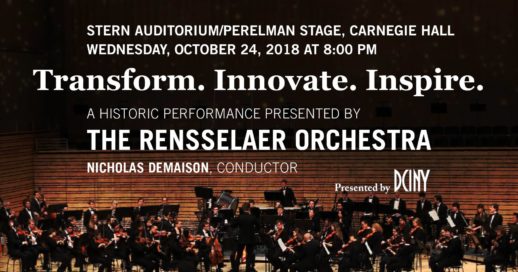Distinguished Concerts International New York (DCINY) presents Transform. Innovate. Inspire in Review
The Rensselaer Orchestra
Nicholas DeMaison, conductor
Shirley Ann Jackson, Ph.D, President of Rensselaer Polytechnic Institute
Stern Auditorium at Carnegie Hall, New York, NY
October 24, 2018
To celebrate the addition of the Bachelor of Science in Music degree at Rensselaer Polytechnic Institute (founded in 1824), Distinguished Concerts International New York (DCINY) presented the newly formed Rensselaer Orchestra in a program called Transform. Innovate. Inspire. – all ideals that Rensselaer emphasizes.
The degree is designed for what the institute calls “21st century careers in music, in fields such as sound design for virtual reality, composition for interactive games, and algorithms for music networks.” While a student may opt for a single major, the idea of pairing with a STEM (Science, Technology, Engineering, Mathematics) discipline is the intent, in a program called Art_X. This pairing of art with another field (“X”) will appeal to a wider demographic of students who have talents in both fields.
Shirley Ann Jackson, the President of Rensselaer Polytechnic Institute spoke before the concert to outline these goals and to thank the many sponsors (individual and corporate) who made this evening a reality.
Bearing in mind that this is an orchestra just formed, and that their numbers were greatly enhanced by the addition of “professional musicians” (the printed program’s designation), it would not be productive to be overly critical. However, there are always some ideals that must be met (intonation, balance, ensemble, etc), and there are no free passes issued. The fact that the program was what most would consider to be a half of a full concert speaks of the challenge of preparing works for concert performance. This is not meant to be a criticism, as it is always better to play a short program well than to struggle with a longer one.
Nicholas DeMaison took the podium to conduct Missy Mazzoli’s River Rogue Transfiguration in its New York City Premiere. Commissioned by the Detroit Symphony Orchestra, River Rogue Transfiguration was inspired by a 1927 photo by Charles Sheeler of the Ford Motor Company’s River Rogue Plant, which was the largest integrated factory in the world. There is a definite “working” sound (think of Raymond Scott’s “Powerhouse” without the cartoonish-ness), which is highly evocative – a ten-minute musical tour of a factory with all the chaos amid highly organized production.
It seems to this listener that the work never quite reached critical mass, that it simmered but never smoldered. A bit more boldness would have made a world of difference, but aside from this reservation, it was a solid performance of a imaginative work.
Sibelius’s Symphony No. 5 in E-flat major, Op. 82 was the final work on the program. Written in 1915 and revised several times (the 1919 final revision was played), it is Sibelius looking both into the past and the future simultaneously with his consummate mastery.
The opening was excellent, which had my expectations heightened for what was to come. The results were variable. While there were moments of sublime playing, there were issues of balance (winds overpowering the strings), some problematic intonation within sections, and a certain timidity in the string section. To be fair, these are all issues that affect much more established orchestras as well. The basics are there, but there is a need for polishing the finer details.
The second movement suffered from heaviness of sound under the lovely “chirping” theme of the woodwinds, an issue easily solved by reining in the exuberance of the brass section. Even with this issue, it was still enchanting.
The strings came into their own in the third movement finale, with incisive, crisp playing and a boldness I had been hoping for earlier. The horn motif (which Donald Tovey likened to “Thor swinging his hammer”) was arresting. The final six staggered chords, all separated by silences, were tossed off like thunderbolts, which was thrilling to hear.
Maestro DeMaison is an ideal conductor for this orchestra. One can see his continual coaching and encouragement to his musicians, his clear and decisive direction, and his unflagging energy. Given time, he should have these players at a higher level that will not require any supplementing from outside musicians.
The supportive members of the Rensselaer community gave their stars a prolonged standing ovation, of which they can feel very proud. Congratulations, and may the program realize the promise of what was launched on this night.

